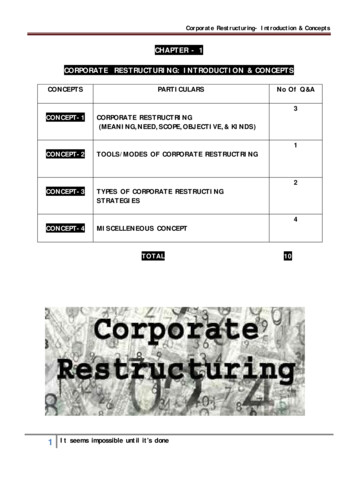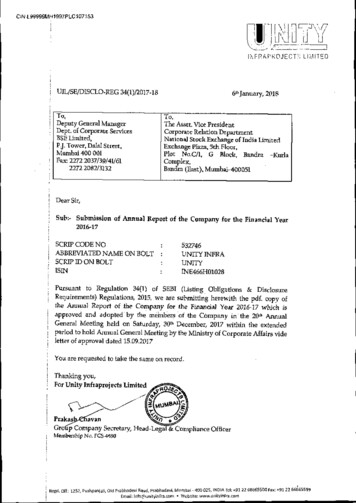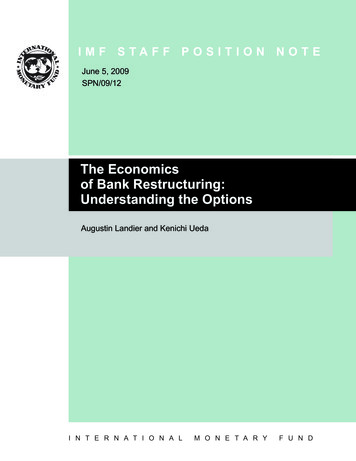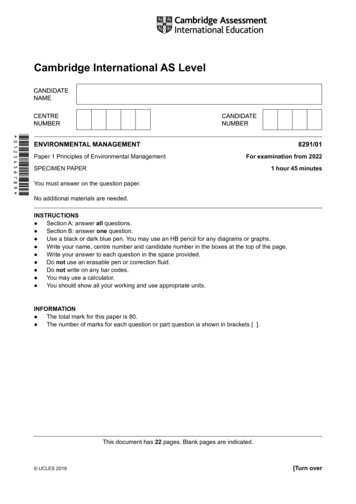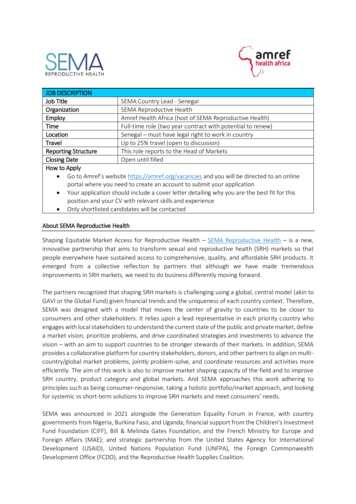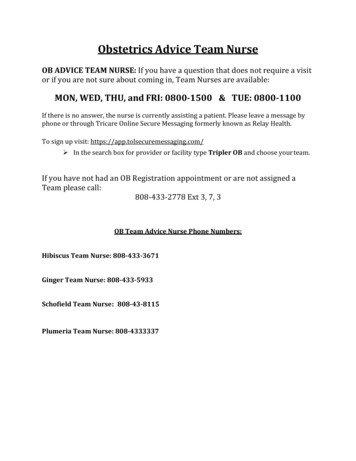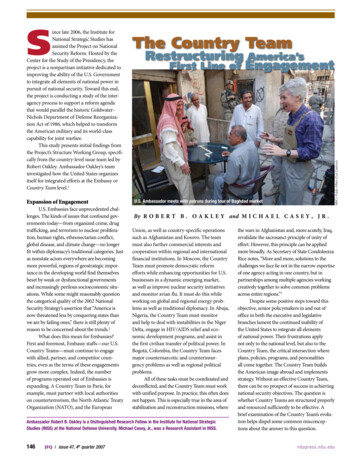
Transcription
Expansion of EngagementU.S. Embassies face unprecedented challenges. The kinds of issues that confound governments today—from organized crime, drugtrafficking, and terrorism to nuclear proliferation, human rights, ethnosectarian conflict,global disease, and climate change—no longerfit within diplomacy’s traditional categories. Justas nonstate actors everywhere are becomingmore powerful, regions of geostrategic importance in the developing world find themselvesbeset by weak or dysfunctional governmentsand increasingly perilous socioeconomic situations. While some might reasonably questionthe categorical quality of the 2002 NationalSecurity Strategy’s assertion that “America isnow threatened less by conquering states thanwe are by failing ones,” there is still plenty ofreason to be concerned about the trends.2What does this mean for Embassies?First and foremost, Embassy staffs—our U.S.Country Teams—must continue to engagewith allied, partner, and competitor countries, even as the terms of these engagementsgrow more complex. Indeed, the numberof programs operated out of Embassies isexpanding. A Country Team in Paris, forexample, must partner with local authoritieson counterterrorism, the North Atlantic TreatyOrganization (NATO), and the EuropeanThe Country TeamRestructuring America’sFirst Line of EngagementU.S. Ambassador meets with patrons during tour of Baghdad marketBy R o b e r t B . O a k l e y and M i c h a e l C a s e y , J r .Union, as well as country-specific operationssuch as Afghanistan and Kosovo. The teammust also further commercial interests andcooperation within regional and internationalfinancial institutions. In Moscow, the CountryTeam must promote democratic reformefforts while enhancing opportunities for U.S.businesses in a dynamic emerging market,as well as improve nuclear security initiativesand monitor avian flu. It must do this whileworking on global and regional energy problems as well as traditional diplomacy. In Abuja,Nigeria, the Country Team must monitorand help to deal with instabilities in the NigerDelta, engage in HIV/AIDS relief and economic development programs, and assist inthe first civilian transfer of political power. InBogotá, Colombia, the Country Team facesmajor counternarcotic and counterinsurgency problems as well as regional politicalproblems.All of these tasks must be coordinated anddeconflicted, and the Country Team must workwith unified purpose. In practice, this often doesnot happen. This is especially true in the area ofstabilization and reconstruction missions, whereAmbassador Robert B. Oakley is a Distinguished Research Fellow in the Institute for National StrategicStudies (INSS) at the National Defense University. Michael Casey, Jr., was a Research Assistant in INSS.146JFQ / issue 47, 4th quarter 2007MNC-I Public Affairs (Curt Cashour)Since late 2006, the Institute forNational Strategic Studies hasassisted the Project on NationalSecurity Reform. Hosted by theCenter for the Study of the Presidency, theproject is a nonpartisan initiative dedicated toimproving the ability of the U.S. Governmentto integrate all elements of national power inpursuit of national security. Toward this end,the project is conducting a study of the interagency process to support a reform agendathat would parallel the historic GoldwaterNichols Department of Defense Reorganization Act of 1986, which helped to transformthe American military and its world-classcapability for joint warfare.This study presents initial findings fromthe Project’s Structure Working Group, specifically from the country-level issue team led byRobert Oakley. Ambassador Oakley’s teaminvestigated how the United States organizesitself for integrated efforts at the Embassy orCountry Team level.1the wars in Afghanistan and, more acutely, Iraq,revalidate the sacrosanct principle of unity ofeffort. However, this principle can be appliedmore broadly. As Secretary of State CondoleezzaRice notes, “More and more, solutions to thechallenges we face lie not in the narrow expertiseof one agency acting in one country, but inpartnerships among multiple agencies workingcreatively together to solve common problemsacross entire regions.”3Despite some positive steps toward thisobjective, senior policymakers in and out ofoffice in both the executive and legislativebranches lament the continued inability ofthe United States to integrate all elementsof national power. Their frustrations applynot only to the national level, but also to theCountry Team, the critical intersection whereplans, policies, programs, and personalitiesall come together. The Country Team buildsthe American image abroad and implementsstrategy. Without an effective Country Team,there can be no prospect of success in achievingnational security objectives. The question iswhether Country Teams are structured properlyand resourced sufficiently to be effective. Abrief examination of the Country Team’s evolution helps dispel some common misconceptions about the answer to this question.n d upress.ndu.edu
OAKLEY and CASEYThe struggle to gain control over unwieldyinteragency activities at the country level isnot of recent vintage.4 As the United Statesemerged from World War II, it engaged inmassive nationbuilding and foreign assistanceefforts to reconstruct European states and tocounter Soviet influence. To undertake thiscommitment, U.S. Government agencies, suchas the Departments of Agriculture, Defense, andTreasury, as well as the Economic CooperationAdministration, dispatched personnel overseasto accomplish U.S. objectives. With the proliferation of agencies and personnel overseas, theexecution of U.S. foreign policy—heretoforeled by the Department of State—became morecomplex.Among the first instances in which onecan find the problem of interagency coordination in the field is President Harry Truman’sdeclaration of economic and military assistanceto Greece and Turkey in 1947. Interestingly, theState Department—to which President Trumandelegated authority of the programs—administered the program differently for each country.In Turkey, the U.S. Ambassador also served asthe chief of the American Mission for Aid toTurkey. In Greece, however, “Dwight P. Griswoldwas appointed . . . to be Chief of the AmericanMission for Aid to Greece, and his missionwas outside and independent of the embassy atAthens and of Ambassador Lincoln MacVeagh.”5Inevitably, the Greeks observed that Griswoldcontrolled the resources, so they bypassed theAmbassador and dealt directly with him. TheAmbassador’s authority diminished, and aconflict within the Embassy emerged. Ratherthan reconfirming the Ambassador’s authorityin the matter, the State Department recalledboth Mr. Griswold and Ambassador MacVeagh,and then deployed a new Ambassador who alsoserved as chief of the aid mission. This course ofaction revealed two longstanding Departmentof State tendencies: the assumption that effectivediplomats can avoid such contretemps, and thedefault position that the Ambassador is ultimately responsible for all Embassy activities.By 1951, with Defense Department andeconomic aid programs expanding overseas,President Truman saw the need to specifymechanisms for coordination at the country andregional levels. General Lucius Clay, who servedas Military Governor in postwar Germany andhelped create the Marshall Plan, undertooknegotiations among government agencies toidentify the best means to achieve coordinationoverseas. Along with establishing the concept ofndupres s.ndu.eduthe Country Team, the resulting Memorandumof Understanding Between the Departments ofState and Defense and the Economic Cooperation Administration—commonly referred to asthe “Clay Paper”—concluded:To insure the full coordination of the U.S. effort,U.S. representatives at the country level shallconstitute a team under the leadership of theAmbassador. . . . The Ambassador’s responsibilityfor coordination, general direction, and leadership shall be given renewed emphasis, and allUnited States elements shall be reindoctrinatedwith respect to the Ambassador’s role as seniorrepresentative for the United States in the country[emphasis added].6The Country Team concept, mentionedfirst in the Clay Paper, is a construct not codifiedin law. It is an executive measure to grant theAmbassador the means to coordinate all U.S.Government activities to maximize the effectiveness of U.S. foreign policy in the country towhich he or she is assigned.Despite the efforts of Presidents Trumanand Dwight Eisenhower through Executiveorders and memoranda such as the Clay Paper,interagency coordination at the country levelremained elusive. Shortly after arriving inthe White House, President John F. Kennedydecided to solve the problem definitively by dispatching a letter to all Ambassadors in which heoutlined his expectations for the Country Team,as well as the authorities at the Ambassadors’disposal.President Kennedy also granted Ambassadors complete authority over the composition of the Country Team, with the provisothat employees of every agency had the rightto appeal to Washington if they found themselves in disagreement with the Ambassador.Additionally, President Kennedy addressedthe issue of military forces engaged in militaryoperations. In such instances, Kennedy declaredthat the Ambassador “should work closely withthe appropriate area military commander toassure the full exchange of information.” If theAmbassador felt “that activities by the UnitedStates military forces may adversely affect ourover-all relations with the people or governmentof [country],” the Ambassador “should promptlydiscuss the matter with the military commanderand, if necessary, request a decision by higherauthority.”7 In contrast, to this day the militaryis not routinely enjoined to work with Ambassadors or to elevate differences of opinion tohigher levels.senior policymakers inboth the executive andlegislative branches lamentthe continued inability of theUnited States to integrate allelements of national powerVignettesOften, those investigating the problem ofintegrating elements of national power at thecountry level conclude that the authority of theAmbassador must be reinforced. However, asthe brief overview of the Country Team conceptillustrates, Presidents repeatedly have reassertedthe Ambassador’s authority, which suggests arecurring problem with the Ambassador’s abilityDeputy Chief of Mission ofU.S. Embassy speaks withcommandant of Philippine marinecorps at opening of bilateraltraining exercisesissue 47, 4th quarter 2007 / JFQ147III Marine Expeditionary Force Combat Camera (Ricardo Morales)Evolution of the Country Team
INTERAGENCY DIALOGUE The Country Teamto generate integrated interagency support forU.S. objectives and interests. A closer look atsome historical vignettes suggests some reasonsfor why this is so.Vietnam: Strategic Hamlets Program.Despite President Kennedy’s intervention, agencies at the Country Team level in the Republicof South Vietnam continued to operate alongtheir own lines of effort. The 1962 StrategicHamlets Program in Vietnam underscored thisfact. The program required U.S. Agency forInternational Development (USAID), militaryadvisors, Central Intelligence Agency (CIA),U.S. Information Agency (USIA), and otherU.S. Government personnel to deploy into theprovinces of South Vietnam and work together.However, the Ambassador to Vietnam believedin allowing each agency full authority overits own programs.8 The result was that eachagency in the field pursued its own objectiveswithout regard to the larger mission. It quicklybecame apparent that the civilian and militaryapproaches to the war in Vietnam during thisperiod were fundamentally at odds.These two diverging approaches were notreconciled. As the military increased its use ofbombs and artillery, civilian casualties mounted,thus undermining the objectives of the StrategicHamlets Program. The program muddled alonguntil the U.S. Government developed a new,more successful structure. Several lessons areillustrated:U.S. Navy (David Hoffman)n Even with high stakes, Presidential attention, and ostensibly clear lines of authority,agencies worked at cross purposes.n It is particularly difficult to reconcilemilitary and other agency objectives.Navy captain briefsU.S. Ambassadorto Honduras andEmbassy staff148JFQ / issue 47, 4th quarter 2007n The Ambassador’s laissez-faire approachwas ineffective, but not atypical, and in factunderstandable.Vietnam: CORDS. In 1966, PresidentLyndon Johnson intervened to correct thepersistent inability of the agencies of the U.S.Government to act in concert. He appointed theDeputy Chief of Mission in Saigon, AmbassadorWilliam Porter, to lead the pacification effortthere. Likewise, President Johnson appointed aNational Security Council (NSC) staff memberto ensure that all agencies in Washington coordinated to provide full support to AmbassadorPorter.9 Nevertheless, the United States failedto achieve unity of effort with the assignmentof two individuals; structural changes were stillneeded. Ambassador Henry Cabot Lodge andmilitary commander General William Westmoreland simply did not work closely together,nor did their staffs. The U.S. Governmentreorganized on multiple occasions to assertcivilian control over the pacification mission,but to no avail. Finally, Robert Komer proposeda new structure—the Civil Operations andRevolutionary Development Support (CORDS)program—which was enacted on May 1, 1967.CORDS successfully unified the efforts ofthe U.S. Government by placing the programin the Headquarters of Military AssistanceCommand–Vietnam (MACV). Komer wasassigned as the Deputy Commander of MACVfor CORDS and given the rank of Ambassador.Ambassador Komer “had status equivalent toa three-star general and ranked third in theMACV hierarchy behind Westmoreland and hismilitary deputy, General Creighton Abrams.”10Yet he was also under the authority and hadthe full support of U.S. Ambassador to SaigonEllsworth Bunker. A combined staff of militaryand civilian personnel supported AmbassadorKomer at Headquarters, MACV, and this structure was replicated down to the district level inall 250 districts in South Vietnam.11Ironically, “subordinating civilian capabilities to the military chain of command actuallyrealized the principle of the primacy of civilpower. This unique placement gave civilian entities greater influence than they ever had beforebecause it provided resources they did not previously have.”12 It also helped to ensure that thepolitical objectives took precedence over thoseof the military. One of the key means by whichcivilians were able to control military activitieswas their newfound responsibility to write performance reports for their military colleagues.the Country Team concept isan executive measure to grantthe Ambassador the means tocoordinate all U.S.Government activitiesAmbassador Komer developed theconcept for CORDS, but Ambassador WilliamColby institutionalized it in MACV and synergized its activities with Ambassador Bunker. Indoing so, Ambassador Colby prevented majorconflicts among civilian and military leaders thatmight have trickled down and complicated collaboration in the field. CORDS’ successes beganto mount, but not before U.S. public opinionturned decidedly against the war. Nevertheless,the case of CORDS demonstrated that:n Formal integration mechanisms atmultiple levels are necessary even with goodindividual leadership.n Changing individual behaviors requiresmore than policy pronouncements fromhigher authority; it requires control of personal incentives.n The ingrained desire for unity of purposein military culture can be used to supportinteragency collaboration in the right decisionmaking structure.Unfortunately, the lessons from CORDSwere lost after the withdrawal from Vietnam,and not highlighted again until a series oflimited interventions in the 1980s and 1990s.Somalia: Operation Restore Hope. Ambassador Robert Oakley, as the Presidential SpecialRepresentative for Somalia, and Combined Jointn d upress.ndu.edu
OAKLEY and CASEYTask Force Commander Lieutenant GeneralRobert Johnston, USMC, had a close, collaborative relationship, as did their staffs. At the time,their relationship was widely identified as amajor contribution to the success of the unitedtask force phase of the Somalia operations.13Since the U.S. Liaison Office was too small fora formal Country Team structure, Oakley andJohnston agreed on alternative informal coordination mechanisms. One of Johnston’s seniorofficers attended all USIA meetings; Oakley’sdeputy chief of mission was Johnston’s political advisor and attended all unified task forcemeetings; and Oakley and Johnston met at leastonce a day. By dint of shared past experience (forexample, Vietnam and Lebanon) and a commoncommitment to collaboration, the critical civilmilitary relationships and complex issues requiring coordination were managed successfully.The question of who was senior never arose, asOakley and Johnston identified and resolved anydifferences quickly. It also helped that the Chairman of the Joint Chiefs of Staff informally toldboth that mission success depended on theirworking well together. This same attitude wasreflected in formal communications with theDepartments of State and Defense.Later, under more trying circumstancesand different leadership, civil-military collaboration deteriorated in a manner that ultimatelycontributed to a precipitous drop in publicand congressional support, withdrawal of U.S.forces, and mission failure. The United Statesand United Nations tried to pursue a two-trackpolicy of fighting and negotiating with a Somaliwarlord without sufficient unity of effort ineither Washington or Mogadishu. Somalia andthe checkered record of interagency collaboration illustrate several points:n Informal coordination mechanisms canwork well if backed by good leaders and theirpersonal commitment.n Senior military leader guidance in favorof civil-military collaboration is helpful.n Without a standing system designed toreward interagency collaboration, successfulinteragency coordination may prove as fleetingas individual leader assignments.Afghanistan and Iraq. In September 2003,facing a difficult transition from a counterterrorism focus to a more robust nationbuilding/counterinsurgency mission in Afghanistan,President George W. Bush appointed ZalmayKhalilzad as U.S. Ambassador to Afghanistan.Khalilzad said he deployed to Afghanistan tondupres s.ndu.edu“ensure the concerted use of all instrumentsof U.S. power to accelerate the defeat of theTaliban insurgency and the reconstructionof Afghanistan.”14 Khalilzad shared this viewwith the U.S. military commander, LieutenantGeneral David Barno, USA, and they were successful in integrating not only U.S. Governmentagencies but also international partners andnongovernmental organizations. One way thatKhalilzad and Barno drove the spirit of unityof effort throughout the Country Team was bylocating their offices adjacent to one another inthe Embassy.When Ambassador John Negropontearrived in Iraq, he and General George Caseyone of the means by whichcivilians were able to controlmilitary activities was theirnewfound responsibility towrite performance reports fortheir military colleaguesalso established adjacent offices to ensure a coordinated, unified approach to U.S. policy. Thiswas a stark change from the practice of Ambassador Paul Bremer and Lieutenant GeneralRicardo Sanchez, USA, whose offices were indifferent buildings and who did not routinelycoordinate with one another, thereby setting apoor example for the Country Team.Under the current Embassy structure inBaghdad:The U.S. Ambassador to Iraq (Ambassador RyanCrocker) has full authority for the American presence in Iraq with two exceptions: 1—military andsecurity matters which are under the authorityof General Petraeus, the U.S. Commander of theMultinational Force–Iraq, and 2—staff workingfor international organizations. In areas wherediplomacy, military, and/or security activitiesoverlap, the Ambassador and the U.S. commander continue cooperating to provide co-equalauthority regarding what’s best for America andits interests in Iraq [emphasis added].15These overviews of ongoing operations,along with the previous vignettes, illustrateseveral key conclusions about the state of interagency collaboration at the country level:n Military authorities retain substantialindependent freedom of action during military operations.n Proximity, informal coordinationmechanisms, and senior leader attitudescan increase the chances for successful civilmilitary integration but do not offer a reliablesystemic solution to the problem.n The United States has not had a structuredsolution for civil-military integration in irregularconflict at the country level since CORDS.The vignettes also illustrate that coordination is difficult even when the stakes are highenough to merit use of force. Counterintuitively,some might wonder if interagency coordination is better when there are less compellingreasons for it. The answer is no. As the case ofaid in Greece and innumerable other anecdotescould illustrate, tensions among Ambassadorsand other government agencies’ representatives,USAID directors, and representatives fromthe Departments of Agriculture, Commerce,and other agencies are commonplace whenthe Ambassador tries to lead in anything otherthan a laissez-faire manner. This does not mean,however, that Country Teams cannot succeedin effectively integrating their efforts when theyhave the right leadership and focused policysupport.South Africa is a case in point. During thetransition period from Apartheid (1992–1994),the U.S. Ambassador successfully built a crossagency working group, which the political counselor chaired. USAID transferred 1 millioneach year to the U.S. Information Agency tofund more short-term visitor training programs;the Defense Attachés went beyond their normalroles to liaison (with Washington’s permission)with the African National Congress “armedforces” leadership to facilitate integration intoa national army; and the Agricultural Attachéprovided invaluable feedback on the farmingcommunities’ attitudes toward the political transition. In sum, the entire team focused on theprimary U.S. objective: to help see a successful,relatively peaceful transition out of Apartheid.16While such examples exist, the fact is that alltoo often, representatives from different agencies pursue their organizational interests at theexpense of a broader, integrated approach forreasons that must be identified if reasonableremedies are to be found.Enduring ProblemsInteragency collaboration is a hit-or-missproposition despite the ostensible authority ofthe Ambassador and the longstanding convention of the Country Team. The core problem,summed up well by the Department of State’sissue 47, 4th quarter 2007 / JFQ149
INTERAGENCY DIALOGUE The Country TeamOverseas Presence Advisory Panel, is that“Other agencies often view the Ambassador asthe Department [of State’s] representative, ratherthan the President’s. The Ambassador is leftwith the responsibility, but not the authority, tocoordinate the activities and address the oftencompeting needs of the mission.”17 Seeing theAmbassador as a Department of State representative who either ignores or willingly sacrificesother agency objectives in favor of State objectives legitimates other organization-centricbehavior that creates major obstacles to unity ofeffort. These obstacles may be grouped in threeoverlapping categories to facilitate examination:authority, structure, and resources.the Presidential letter toAmbassadors does not spellout the specific responsibilitiesof other agencies vis-à-vis theAmbassadorDiluted Authority. Ambassadors do nothave adequate explicit authorities to unify theefforts of the Country Team, and their taskhas only grown more difficult in recent years.Not only must Ambassadors coordinate majorgovernment activities such as diplomacy,commercial relations, use of force, and intelligence activities, but they also must provideinteragency coordination for numerous subspecialties within a given area. With over 30government agencies now dispatching employees overseas, non–State Department personneloften outnumber diplomats.18 As noted earlier,the Presidential letter to Ambassadors lays outtheir overarching authority but does not spellout the specific responsibilities of other agenciesvis-à-vis the Ambassador. Personnel from government agencies often deploy to the CountryTeam without understanding that the Ambassador is the President’s representative. Theydo not receive adequate guidance from theiragencies on relationships with the Ambassadorand with other agencies, nor do they receivethorough briefings on the Presidential letter andits intent. This is particularly true of personnelfrom the Departments of Defense, Justice, andTreasury, as well as other government agencies.In particular, Ambassadors lack the proper toolsto exert their authority, such as effective controlover employee performance reports.Because the Ambassador is often not seenas the overarching national representative, agencies encourage their personnel on the Country150JFQ / issue 47, 4th quarter 2007Team to pursue their own objectives and linesschemes. As agency representatives bypassof operation, without adequate consultation orthe Ambassador and obtain guidance directlycoordination. Some of these agency personnel,from Washington bureaus, Ambassadors areas the late George Kennan observed, “seem toisolated from the operations of other agencies,operate directly or indirectly under the authorityand the de facto autonomy of other agenciesof Washington bosses, some in the State Departgrows. Direct communications with superiorsment, some elsewhere.”19 This state of affairs,in the home agency without the Ambassador’she added, “invites . . . the foreign ambassadorknowledge also reinforce an informal incentiveand ambassadorial staff stationed in Washsystem that rewards individual agency-centricington to take their problems directly to otherbehaviors.departments and agencies, bypassing the StateThe increasing reliance upon contractorsDepartment entirely.”20 Without an adequaterather than direct-hire government personvoice in the performance assessment of agencynel can lead to a serious diminution in theleads and vice versa, there are no built-in inceneffectiveness, timeliness, and accountabilitytives to putting the priorities of theCountry Team above those of individual agencies. When rare exceptions to this general rule have beenmade—as in the administrationof the CORDS program duringVietnam—results were positive.21The White House, and tosome degree the Departmentof State, does not pay sufficientattention to the Ambassador’sauthority vis-à-vis other agencies, thereby compoundingthe problem. In many cases,support for the AmbassadorDeputy Chief of Mission to U.S. Embassy in Gabon and Navyfrom State depends largely on the officers meet with Mayor of Port Gentil, Gabon, to discuss regionalimportance of the post, personal maritime partnershipU.S. Navy (Anthony Dallas)influence of the Ambassador,or critical nature of the issue, rather than onof U.S. activities if direct Embassy oversightthe institutional role of the Ambassador asis not provided (for example, police trainingthe President’s representative. The mistakenin Iraq and Afghanistan). Contractors andassumption is that the Ambassador andsubcontractors are not viewed as an extenCountry Team are not necessary to tee upsion of the Country Team and, in fact, are notfeasible policy options for Washington. Theireven counted in the mission’s complement ofopinions and insights usually are not valuedU.S. personnel in country, except for securityhighly enough when it comes to designingpurposes. As a result, the Ambassador’s abilitypolicies and setting priorities. In addition,to oversee the operations of these personnelsince Washington does not do a good job ofwhile in country is largely dependent upon theintegrating its priorities, Ambassadors lack afunding agency’s availability and commitmentframework for balancing valid but competingof direct-hire supervisory staff to the Embassyinterests. Currently, for example, counterterwho can provide accountability to the Countryrorism often overwhelms other issues, noTeam. This problem applies to civilian andmatter what the country, and “new” butmilitary contractors.important issues such as health and the enviThe Ambassador understandably has noronment do not receive adequate attention orauthority over nongovernmental organizationsrecognition in Washington.or U.S. businessmen. Yet many AmbassadorsAnother manifestation of the indeignore the opportunities these organizations andpendence of other agencies in the field and aindividuals present for improving and spreadingmajor reason the Ambassador finds it difficultU.S. influence in a more cohesive fashion. Theto provide effective oversight is informalprivate sector in particular is a valuable asset inparallel communications. The proliferationpromoting U.S. values and policies, but it is oftenof email and cellular phones has created newignored by the Country Team for other thanchannels outside of formal communicationscommercial or security issues.n d upress.ndu.edu
OAKLEY and CASEYFinally, in crisis situations, such as therecent tsunami in Southeast Asia or the Pakistan earthquake, diverse ad hoc organizationalstructures further undermine the Ambassador’sability to coordinate activities. There is no commonly accepted and established mechanism forthe Ambassador to use when multiple agenciesand their personnel surge into the country. Eachagency in Washington has its own offices torespond to emergencies, conflict, or failed states,and they often do so without adequate coordination. Civilian policy and civil-military coordination at the regional level is underpowered, soAmbassadors and their country-level programscannot be coordinated
To insure the full coordination of the U.S. effort, U.S. representatives at the country level shall constitute a team under the leadership of the Ambassador. . . . The Ambassador's responsibility for coordination, general direction, and leader-ship shall be given renewed emphasis, and all United States elements shall be reindoctrinated



